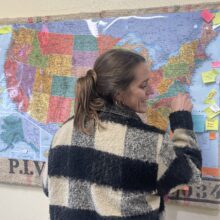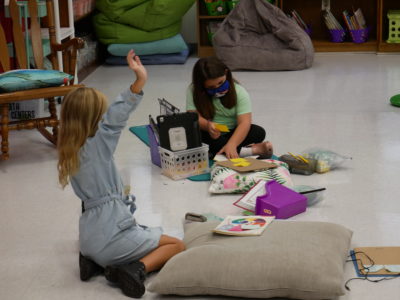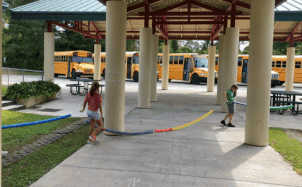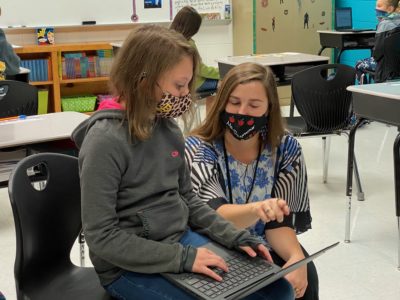On Sept. 2, Superintendent Tanya Turner walked the one-directional halls of Perquimans High School. Tables were placed like a highway median, encouraging students to keep moving. This design to create one-way traffic streams was the genius of the P.E department. They moved all the tables from the building into the hallways, and for the hallways too small in width, they placed traffic cones. It’s a “doesn’t look pretty, but it’s effective” kind of strategy, Turner says.
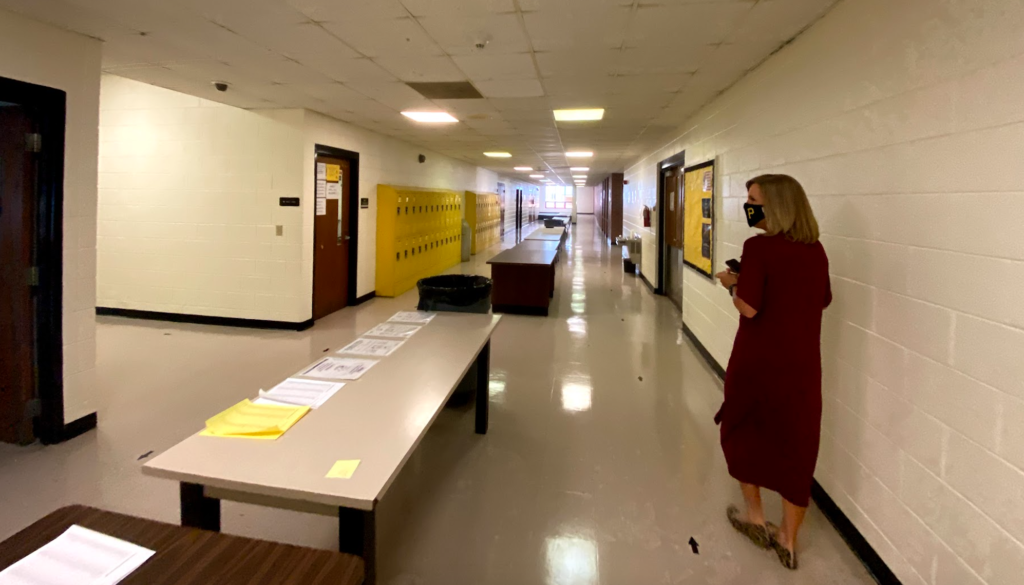

Perquimans County Schools opted for plan B from the beginning, and the district has been able to keep operating under this plan by employing many small strategies like the one described above.
This district, along with Pitt County, were the only districts in northeastern North Carolina that chose to enact a hybrid model of online and in-person instruction beginning on the first day of school. While there have been COVID-19 cases among the school population, Turner assured the community in a press release on Oct. 1 that she aims for “transparent communication” while the schools continue to operate.
“By working together, we will follow the data, along with state and federal guidance, to ensure we are making the best decisions possible for our communities. We will strive to find that balance of normalcy and safety to the best of our ability. Unfortunately, as we have all seen with the recent rise in lab confirmed cases throughout our region and North Carolina, we know we will see COVID-19 cases. What is most important is how we all work together to mitigate that impact and strive to keep our communities as healthy and safe as possible, and as you know, that lies not only in what we do as a school system and health district, but also in what we do as individual citizens, following the necessary precautions to keep each other safe.”
Tanya Turner, superintendent of Perquimans County Schools in a press release
As of Sept. 29, Turner announced that the Perquimans County School Board of Education approved plans to move toward plan A. Grades K-8 will have a four day, in-person instruction schedule, with the option for families to continue participating in plan C, or fully remote instruction. The details of the changes to the district’s strategy can be found here.
How has this rural district succeeded in creating a safe environment for in-person instruction? Through nimble leadership, dedicated staff, a supportive community, and a school board that listened.
“It’s been a team effort across the board, everybody working together.”
Tanya Turner, superintendent of Perquimans County Schools

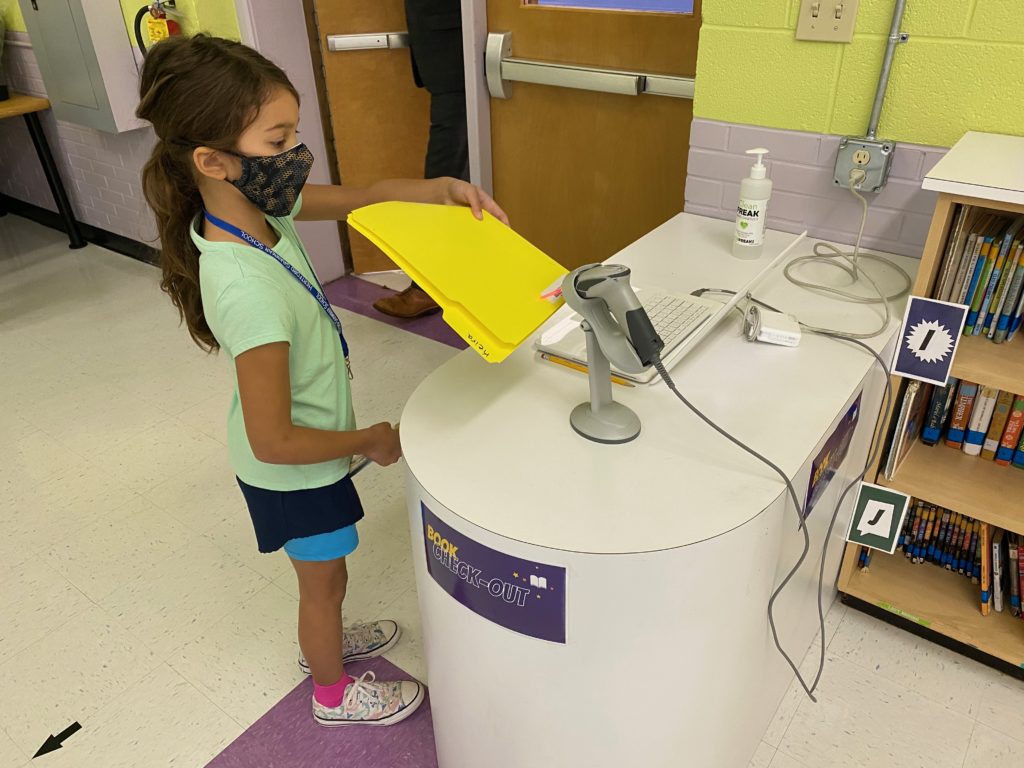

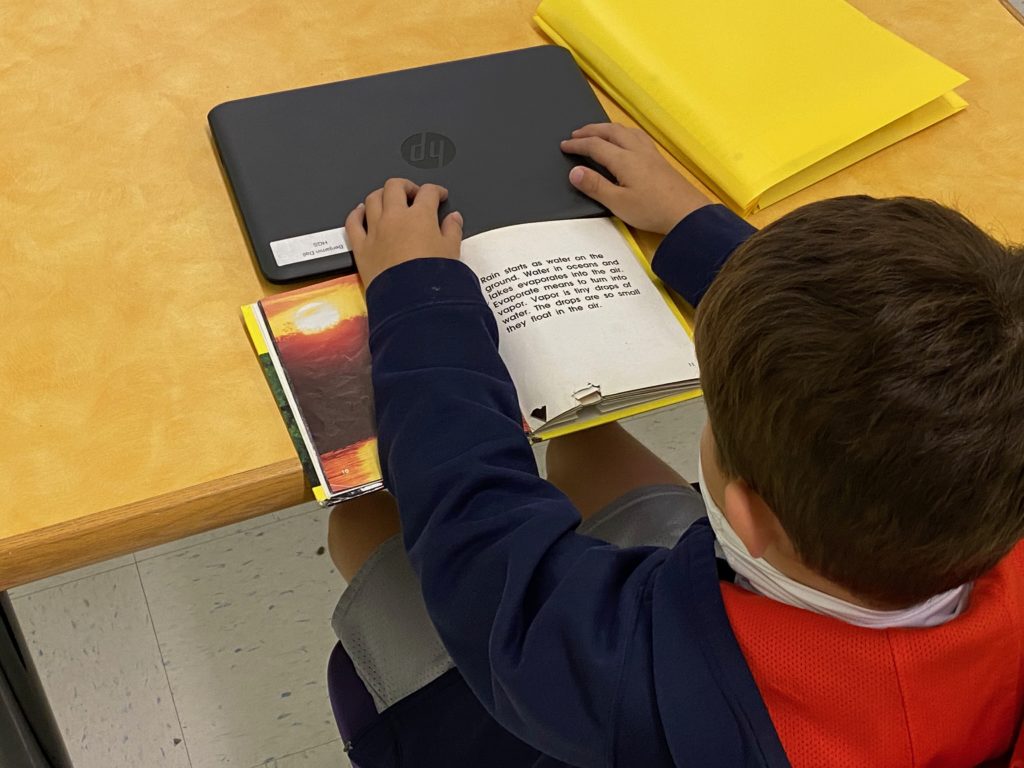

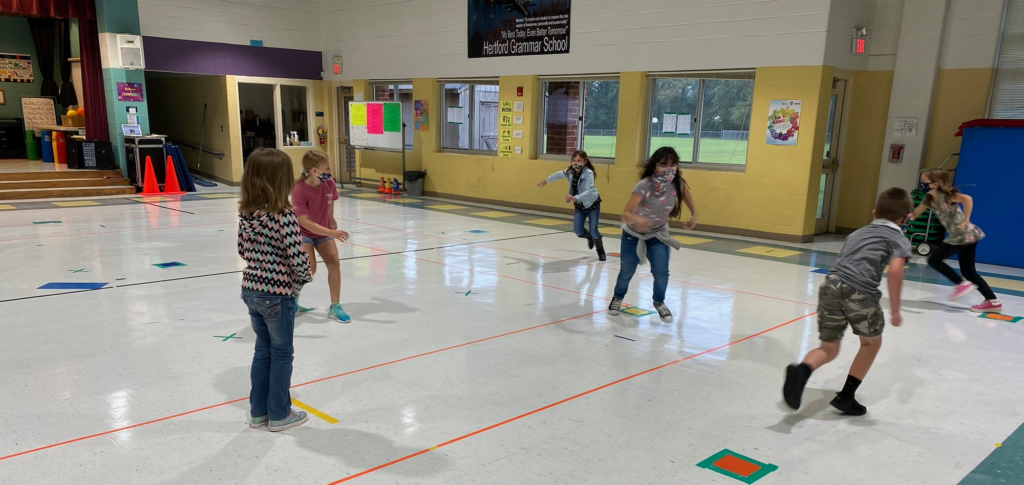
Students at Hertford Grammar School. Alex Granados/EducationNC
Perquimans by the numbers
Perquimans County is 247 square miles of land. Through the middle of the county runs the Perquimans River, 82 square miles of a coastal waterway leading to the Albermarle Sound. The school district currently has 1,642 students in four schools; Perquimans Central (grades preK-2), Herford Grammar (grades 3-5), Perquimans Middle (grades 6-8), and Perquimans High (grades 9-12).
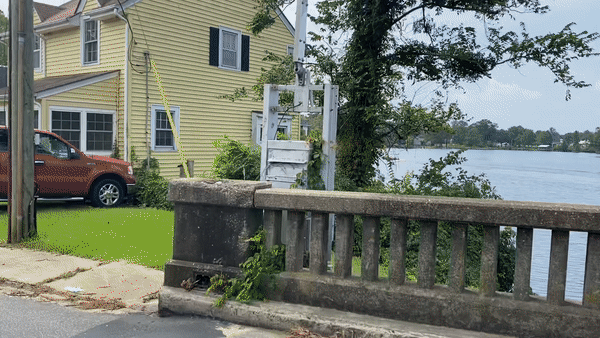

A key part of Turner’s success was surveying students’ families multiple times leading up to this school year. The first survey was given at the end of the 2019-20 school year to receive feedback about remote learning. It asked what worked, what didn’t work, and gave the opportunity for parents to leave suggestions or identify obstacles. This informed the central office’s summer planning.
The second survey, sent during the summer, was demographic-heavy and asked the most pressing question to parents: Given the options, which instructional plan would you want for your child? Answers to this survey informed the plan the district was going to present to the school board.
From this survey, the district determined that 30% of their parents wanted fully remote instruction and 70% wanted face-to-face instruction. Overwhelmingly, the survey also surfaced a collective priority of the community — to get the youngest learners in school.
“It was a priority to get our younger kids in school as many days as possible because of developmental needs as well as parent needs for child care and work.”
Tanya Turner, superintendent of Perquimans County Schools
The third survey came after the governor laid out the options for school reopening. This was specifically for parents to sign their child up for full-time remote learning so that the district could start strategizing bus routes and planning logistics.
People were very passionate about what the decision was going to be made, says Turner. The night she presented their reopening plan to the board, more than 1,000 people logged in to watch the meeting on Facebook live. The school board approved the district’s plan B model, which reflected both options the community wanted.
Turner believes that giving families a choice and a voice is one reason why the district’s average daily membership, or ADM, has stayed level. “A lot of school districts are suffering with their ADM. We’re not. We’re blessed in that our ADM this year is just about the same as it was last year. And I think that is because our community was behind us going back to school,” she said.
“The parents that wanted face-to-face got face-to-face, the parents who wanted remote got remote. So they stayed with us.”
Tanya Turner, superintendent of Perquimans County Schools
Why their plan B worked
Perquimans is a one-to-one school district, meaning each student has a device to use in and out of school. Through the second survey, the district found that 30% of their families struggle with internet connectivity issues. The district purchased hot spots and are providing for any household that needs one.
But there are still homes located in Wi-Fi deserts, and community partners stepped up to help. Inteli-Port, a local internet provider with an office in downtown Hertford, established multiple points of connection throughout the county by either installing or improving Wi-Fi. These locations range from churches to campgrounds, and the full list was published online for students.
Plan B structure
- Monday: Grades 9-12 have in-person instruction at Perquimans High School. They are remote all other days.
- Tuesday to Friday: PreK-6 grade have in-person instruction at all four schools. They are remote on Mondays.
- Tuesday and Wednesday: Grades 7-8 have in-person instruction from 9:30 a.m. to 1:30 p.m. at Perquimans High School. They are remote all other days.
There are 28 school buses in Perquimans County. The buses pick up all K-6 graders first, then go back and pick up seventh and eighth graders on Tuesday and Wednesday. In plan B, the district has 32% of students receiving fully remote instruction, and everyone else is participating in the hybrid model.
Most educators are teaching both in-person and online, and doing both models of instruction at the same time. The strategy there was if the state mandates that everyone move back to fully online instruction, it would be a smooth transition.
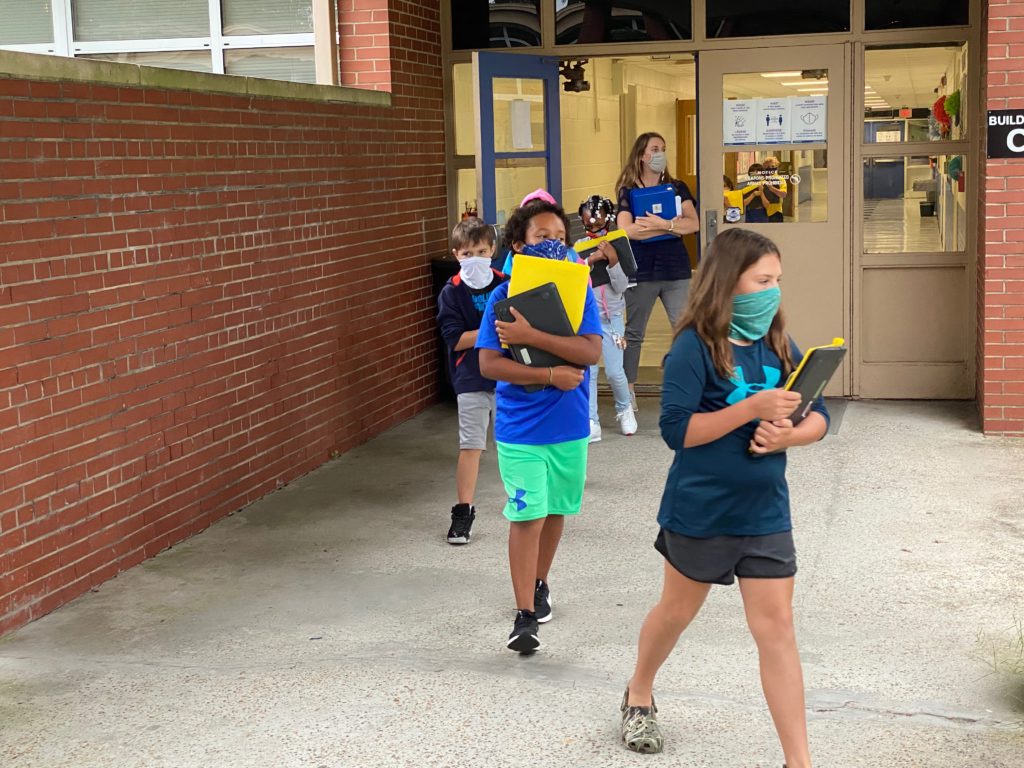

Small strategies make big differences
Starting with student drop-off, just about everything had to be thought through and altered in someway. At Perquimans High School, there are two entry points with kiosk temperature checks. The machine not only detects and records your temperature, it warns the system if a mask is not on. Car riders come in through one entry, bus riders through another. Nurses have hand-held thermometers for all other instances.

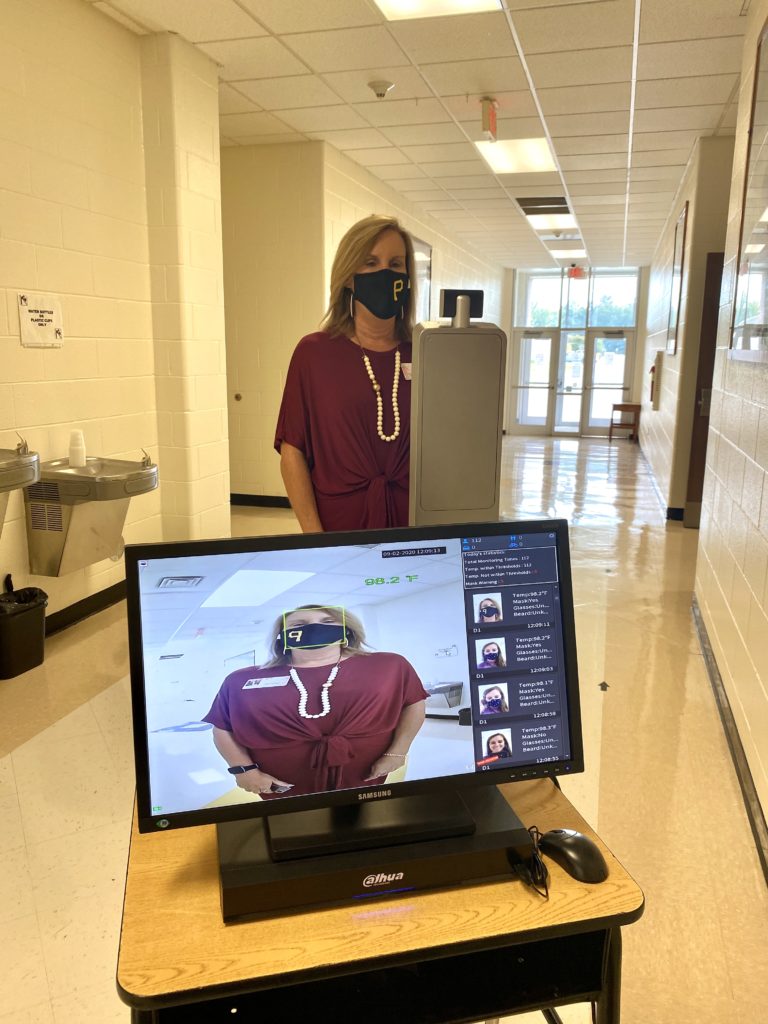
Superintendent Turner at temperature check kiosk. Caroline Parker/EducationNC 
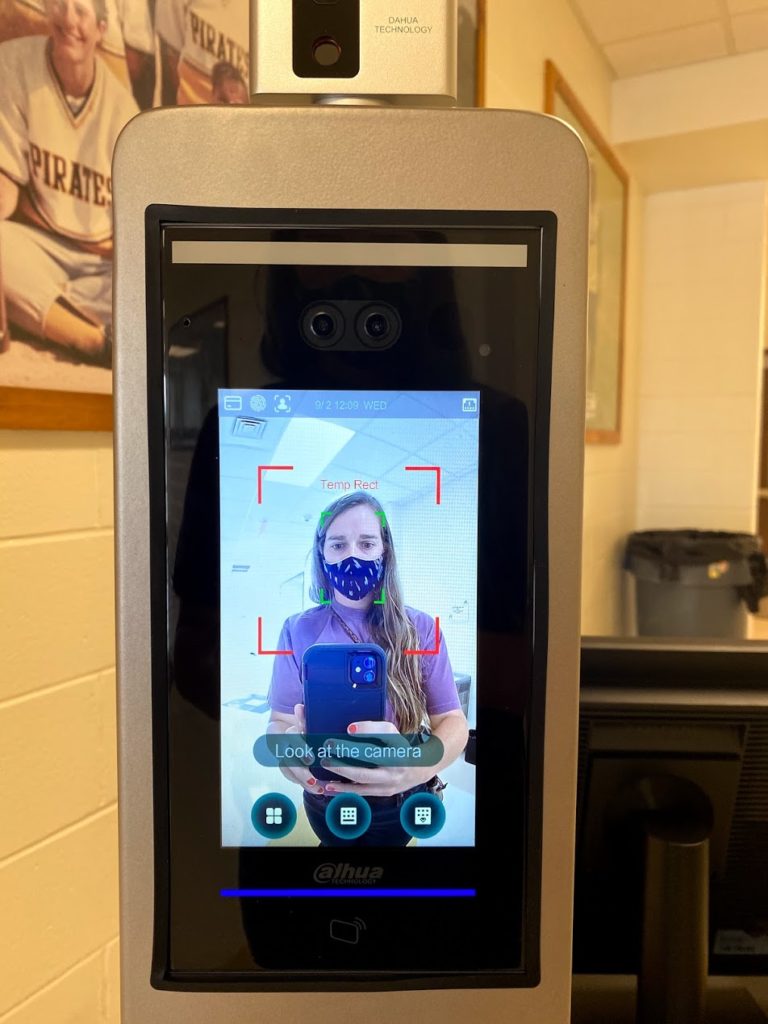
Temperature check kiosk at Perquimans High School. Caroline Parker/EducationNC
In the car line at Perquimans Central, one teacher walks down the row with health screening questions and parents have to give a thumbs up to indicate if all has been well since the student last attended school.
For high school and middle school pick-up, there are blue dots on the bleachers in the gym, spaced 6 feet apart, where kids sit and wait. A teacher is outside in the car line on a Google document, and when a parent comes to get them, they type their name in, and another teacher in the gym calls out the name. Students come out in order, the pace is fast, and the system is efficient.
Another huge part of the district’s safety strategy has come from weekly meetings with Albemarle Regional Health. They started having a weekly regroup to discuss protocols and strategies to keep everyone safe. Recently, they have moved to meeting every other week. Meetings are open to all staff, and usually school nurses attend as well as a school board member.
Turner praises this relationship with Albemarle Regional Health, and feels if there is any question, she has a direct line of communication. Knowing she can tell her community that the district has consulted with health officials to put these strategies in place carries a lot of weight, she says.
Albemarle Regional Health has put together scenarios for Perquimans County, and those options continue to grow as new situations arise. It’s as simple as “if this happens, this is what you should do,” says Turner. In times like these, it is helpful to have easy, digestible instructions for everyday scenarios, with appropriate responses to keep everyone safe.
All these little alterations to the pre-pandemic school routine are what have led the district to a successful start of this year. Plus, Turner adds, “the teachers are definitely working harder than they’ve ever had to work before.”
It has been a district-wide, all hands on deck effort to open school. Turner credits every staff member — from maintenance and the custodial department to bus drivers and teachers — for the reason things have been able to run smoothly.
Turner has lived in Perquimans County her whole life and can’t speak better of the community, especially during the pandemic. They are also part of the group effort that has allowed schools to open under plan B.
“The community support has been so overwhelmingly positive, it can do nothing but lift you up.”
Tanya Turner, superintendent of Perquimans County Schools
